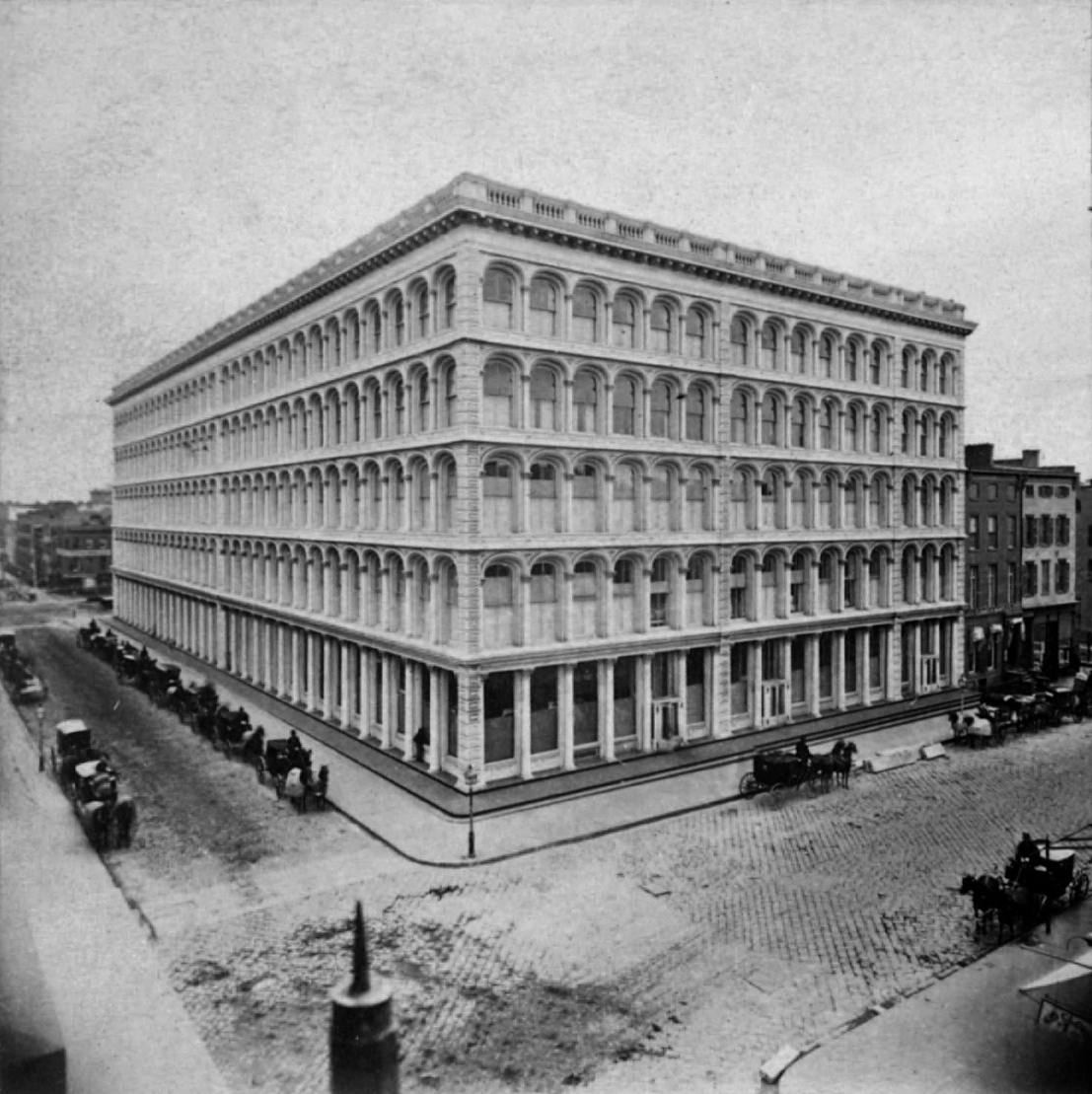John Kellum on:
[Wikipedia]
[Google]
[Amazon]
John Kellum (1809–1871) was an American architect in practice in New York City.
Kellum, born in  Kellum designed and built for Stewart the Working Women's Hotel (1869–75, demolished), on Park Avenue between 32nd and 33rd Streets.
In addition to his work on Stewart's projects, Kellum designed a number of commercial structures during the 1860s: the Ball, Black & Company building, 565-67 Broadway (1858–60, standing); the cast-iron building at 55 White Street (1861, standing); Mutual Life Insurance Building, 140-46 Broadway (1863–65; demolished); the cast-iron Fulton Ferry Terminal (1863, demolished); the former
Kellum designed and built for Stewart the Working Women's Hotel (1869–75, demolished), on Park Avenue between 32nd and 33rd Streets.
In addition to his work on Stewart's projects, Kellum designed a number of commercial structures during the 1860s: the Ball, Black & Company building, 565-67 Broadway (1858–60, standing); the cast-iron building at 55 White Street (1861, standing); Mutual Life Insurance Building, 140-46 Broadway (1863–65; demolished); the cast-iron Fulton Ferry Terminal (1863, demolished); the former
Hempstead, Long Island
The Town of Hempstead (also known historically as South Hempstead) is the largest of the three Administrative divisions of New York#Town, towns in Nassau County, New York, Nassau County (alongside North Hempstead, New York, North Hempstead and Oys ...
, was trained as a carpenter
Carpentry is a skilled trade and a craft in which the primary work performed is the cutting, shaping and installation of building materials during the construction of buildings, Shipbuilding, ships, timber bridges, concrete formwork, etc. ...
; he was largely self-taught in architecture, and was taken into partnership in 1846 by the well-established New York architect Gamaliel King
Gamaliel King (Shelter Island, New York, 1 December 1795 — 6 December 1875) was an American architect who practiced in New York City and the adjacent city of Brooklyn, where he was a major figure in Brooklyn civic and ecclesiastical architectur ...
. King was engaged in constructing Brooklyn City Hall, and Kellum, as junior partner, was his on-site supervisor. Together they established a reputation for constructing many of the new cast-iron commercial buildings that changed the aspect of New York. They remained in partnership until 1859, when Kellum left to open a practice in partnership with his son.
Kellum received his first big independent commission as the architect to Alexander T. Stewart
Alexander Turney Stewart (October 12, 1803 – April 10, 1876) was an American entrepreneur who moved to New York and made his multimillion-dollar fortune in the most extensive and lucrative dry goods store in the world.
Stewart was born in L ...
, the department store
A department store is a retail establishment offering a wide range of consumer goods in different areas of the store, each area ("department") specializing in a product category. In modern major cities, the department store made a dramatic app ...
magnate, designing the A.T. Stewart store at Broadway and 10th Street (1859–62, demolished), which occupied the entire blockfront He designed Stewart's marble mansion on the northeast corner of Fifth Avenue and 34th Street, that was the first of Fifth Avenue
Fifth Avenue is a major and prominent thoroughfare in the borough of Manhattan in New York City. It stretches north from Washington Square Park in Greenwich Village to West 143rd Street in Harlem. It is one of the most expensive shopping stre ...
's marble palazzos.
 Kellum designed and built for Stewart the Working Women's Hotel (1869–75, demolished), on Park Avenue between 32nd and 33rd Streets.
In addition to his work on Stewart's projects, Kellum designed a number of commercial structures during the 1860s: the Ball, Black & Company building, 565-67 Broadway (1858–60, standing); the cast-iron building at 55 White Street (1861, standing); Mutual Life Insurance Building, 140-46 Broadway (1863–65; demolished); the cast-iron Fulton Ferry Terminal (1863, demolished); the former
Kellum designed and built for Stewart the Working Women's Hotel (1869–75, demolished), on Park Avenue between 32nd and 33rd Streets.
In addition to his work on Stewart's projects, Kellum designed a number of commercial structures during the 1860s: the Ball, Black & Company building, 565-67 Broadway (1858–60, standing); the cast-iron building at 55 White Street (1861, standing); Mutual Life Insurance Building, 140-46 Broadway (1863–65; demolished); the cast-iron Fulton Ferry Terminal (1863, demolished); the former New York Stock Exchange
The New York Stock Exchange (NYSE, nicknamed "The Big Board") is an American stock exchange in the Financial District of Lower Manhattan in New York City. It is by far the world's largest stock exchange by market capitalization of its listed c ...
, Broad Street (1865, demolished); the New York Herald Building, Broadway (1865–67, demolished); the James McCreery & Company Building, 801 Broadway (1868, standing) and the Tiffany & Company Building, 15 Union Square West (1870)
At the time of his death Kellum was occupied in an even grander project for Stewart, laying out Garden City, Long Island
Garden City is a village located on Long Island in Nassau County New York. It is the Greater Garden City area's anchor community. The population was 23,272 at the 2020 census.
The Incorporated Village of Garden City is primarily located withi ...
on the tract in Hempstead township that Stewart had bought. It was one of the first American " garden city" planned suburbs.
Kellum was also the primary architectThomas Little, a political appointee on the New York City Board of Supervisors, was also credited. of the New York County Courthouse (1861 onwards; completed with revised and elaborated interiors, 1881), on Chambers Street behind New York City Hall; it is known as the "Tweed Courthouse" after William Marcy "Boss" Tweed, who commissioned it and profited from kickbacks during its construction. Kellum's exterior is in the Italianate manner; immense cast-iron structural and decorative elements are to be seen in the public spaces of the rich interiors.
Notes
{{DEFAULTSORT:Kellum, John 1809 births 1871 deaths 19th-century American architects